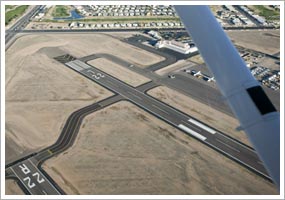
The following stories from the January 11, 2008, edition of AOPA ePilot were provided to AOPA members who expressed an interest in the particular subject areas. Any AOPA member can receive information tailored to their areas of interest by updating their preferences online.
My ePilot - Student Interest, Training Tips
SHARING YOUR AIRSPACE
 You have learned the correct method for safely entering the traffic pattern at nontowered airports, and you've studied right-of-way rules that keep different categories of aircraft safely separate. (See the May 2, 2003, "Training Tips" on right-of-way rules.) Now you're ready to put these concepts to the test as you endeavor to operate safely in the presence of other airport users.
You have learned the correct method for safely entering the traffic pattern at nontowered airports, and you've studied right-of-way rules that keep different categories of aircraft safely separate. (See the May 2, 2003, "Training Tips" on right-of-way rules.) Now you're ready to put these concepts to the test as you endeavor to operate safely in the presence of other airport users.
After you check airport publications for your destinations' radio frequencies, runway lengths and bearings, and facilities, be sure to look up what other kinds of air traffic might be present. "To airplane pilots, the ways of helicopters, gliders, and balloons seem mysterious. Knowing how they come and go helps you to coordinate your departures and arrivals with theirs. Being familiar with their operation is comforting when you scan for traffic because you know where to look for them. Chatting with their pilots and asking some questions (perhaps even going for a ride) is hugely helpful," was the advice offered in the October 2007 AOPA Flight Training column "Accident Analysis: Mixed Company."
Towplanes and gliders may use only the runway that is closest to the glider operation's base; you may need to use another because of reported surface winds. Large airplanes may use only the longer runways and fly a higher traffic pattern. Parachute jumping could be under way; what frequency is used to advise local aircraft about "jumpers away"? Helicopter pilots are responsible for avoiding the flow of fixed-wing aircraft, but keep an eye out for them in the pattern and while taxiing. Instrument approaches flown for practice by pilots training for the instrument rating could be in progress. These aircraft train with different arrival routes than aircraft making routine arrivals under visual flight rules. Ask your instructor to describe instrument training that could be in progress and what to listen for on the common traffic advisory frequency (CTAF). If there is a floatplane base on an adjacent body of water such as a river or lake, visualize its traffic pattern. Does the seaplane base use the same CTAF as the airport?
Experience will make these other kinds of aviation activity more familiar. Meanwhile, do your research and ask questions to fill in the gaps.
My ePilot - Training Product
KEEP NOTES HANDY WITH SPORTY'S WRISTWRITER
Sometimes you find yourself in the cockpit without a scrap of paper when you need one. Fortunately, you won't have to scribble a clearance, frequency, or altimeter setting on your hand with the WristWriter from Sporty's. The WristWriter is an adjustable wrist band fitted with scrollable, water-resistant paper. The device, which comes with its own mechanical pencil, sells for $19.95 and can be ordered online or by calling 800/SPORTYS.
Note: Products listed have not been evaluated by ePilot editors unless otherwise noted. AOPA assumes no responsibility for products or services listed or for claims or actions by manufacturers or vendors.
My ePilot - Student Interest, Final Exam
Question: Can you please explain what "ground effect" is?
Answer: Ground effect is caused by the interference of the ground surface with the airflow pattern about the airplane in flight. When the wing is under the influence of ground effect, there is a reduction in upwash, downwash, and wingtip vortices. It can be detected and measured up to an altitude equal to one wingspan above the surface and is most significant when the airplane is maintaining a constant attitude at low airspeed close to the ground. A decrease in induced drag makes the airplane seem to float on a cushion of air beneath it, so if a power approach is being made, the power setting should be reduced as the airplane descends into ground effect to avoid overshooting your desired touchdown point. More information on this subject is discussed in the article "Ground Effect: Flying in the Realm of Altered Air Flow."
Got a question for our technical services staff? E-mail to [email protected] or call the Pilot Information Center, 800/872-2672. Don't forget the online archive of "Final Exam" questions and answers, searchable by keyword or topic.


